Maizetrust.co.za
Project reportProject Title: Determination of the emergence pattern and injuriousness of
Spotted Maize Beetle Astylus atromaculatus (Coleoptera:
Melyridae) adults on grain sorghum.
Project Manager: Prof. H. Du Plessis
Co-workers:
Prof. J. van den Berg Project duration: 1/12/2010 – 30/11/2012
Background and Explanation of project
Insect pests attacking panicles of sorghum are very damaging since they affect crop development at a late stage and have direct harmful quantitative and qualitative effects on grain yields (Harris, 1995). Adult spotted maize beetles (Astylus atromaculatus Blanchard) (Coleoptera: Melyridae) are abundant from December till March (Drinkwater, 1997), which coincides with the grain sorghum producing Astylus atromaculatus has only one generation per year. The first beetles emerge from their pupal cells under the soil surface from approximately mid-December onwards. Their numbers increase rapidly, peaking in January and February. Newly emerged beetles aggregate and hang in clusters on leaves of young maize plants, certain grasses and weeds, and on immature sorghum heads. Adults fly actively and invade maize and sorghum fields as plants commence tasseling and pollen becomes available (Drinkwater, 1998). Effective control of Astylus beetles is hampered by unknown ecological aspects. For example, it is not known if beetles emerging from pupal cells remain in the same field or if crop fields are invaded from elsewhere. The behavioural responses of the beetles to confinement in mesh cages on sorghum panicles caused previous attempts to determine its injuriousness to be unsuccessful. Insecticide applications will have to be accurately timed if there are large scale migrations of these beetles to sorghum fields from other crops or surrounding grass lands. On the other hand, if they emerge from the same field which they infest during the flowering stage it will be possible to do carefully timed insecticide applications against this pest. No accurate information is available on the emergence pattern of these beetles during the sorghum production season although it is known that they invade fields during the flowering stage. If beetles emerge from the same field that they infest (in other words no mass immigration) the planting of another crop (such as maize) of which flowers are also damaged but without any economic impact, may help to control the pest. Furthermore, if no mass migration occurs, then certain soil cultivation practices could be employed to suppress this pest. Since Astylus beetles have only one cycle per annum, an effective control measure can have a huge impact in suppressing damage caused by this pest in following years. Knowledge on the emergence pattern and possible immigration of these beetles into sorghum fields can therefore contribute to effective control of Astylus beetles. Beetles feed on grain sorghum inflorescences, which result in chaffy panicles due to reduced pollen availability and damage to developing grain. Loss of seed takes place as a result of the activity of beetles on panicles. Apart from direct yield losses caused by beetles, damaged grain show secondary fungus infections. Grain mold pathogens have been associated with losses in grain mass (Castor & Frederikson, 1980; Hepperley, Felciano, & Sotomayor, 1982), grain density (Ibrahim, Nyquist, & Axwell, 1985) and percentage germination (Maiti, Raju, & Bidinger, 1985). A research project was previously funded by the Sorghum Trust and conducted by the authors of this study on the efficacy of insecticides registered for control of Astylus beetles (gamma-BHC and mercaptothion), H. armigera (esfenvalerate, permethrin, cypermethrin, lambda cyhalothrin, deltamethrin and methomyl) and aphids (endosulfan and demeton-S-methyl) on grain sorghum. Significant differences in insecticide efficacy were observed but insecticides were generally ineffective. Gamma-BHC was only 53 % effective, but methomyl, registered for control of H. armigera in sorghum was 100 % effective. Since the residual action of this insecticide is short and the possibility of reinfestation by beetles exists, control may not be effective over the long term. Economic threshold levels can be determined which will result in optimal timing of insecticide applications. This will ensure effective control at a reduced number of insecticide applications which will be economically advantageous to producers. To determine the level of damage and possibly an economic threshold level, experiments under controlled levels of infestation per sorghum panicle is needed. Previous attempts were, however, unsuccessful due to the behavioural response of A. atromaculatus beetles to confinement in mesh cages on panicles. When confined, beetles did not feed on ears and aggregated on the mesh cage itself. Preparatory technique development is therefore essential to address this behavioural response before trials can be executed to ensure reliable results. The objectives of this study were therefore to develop techniques and do a preliminary study to assess the damage caused by these beetles to sorghum. Specific aims were to:
determine what proportion of Astylus beetles present in fields emerge from pupal cells in the same field (Year 1 and 2) determine the emergence pattern of beetles over the season (Year 1 and 2) develop a caging technique on sorghum panicles that will facilitate future study of this pest (Year 1) to assess damage caused by these beetles to sorghum panicles during the flowering, soft and hard dough stages (Year 1 and 2) Monitor A. atromaculatus flights by means of volatile compounds that are attractive to beetles (Year 2) Additional aims were added during the study to interpret the results obtained. Additional aims were to:
sample A. atromaculatus adults in mass record A. atromaculatus on grasses outside a sorghum field Material and methods
1. Astylus atromaculatus beetle emergence pattern
Year 1 and 2
Ten cages (1.5 (l) x 0.5 (w) x 0.3m (h)) (Fig. 1) was placed randomly in one sorghum and three near-by maize fields at the ARC - Grain Crops Institute, Potchefstroom (26°44'S; 27°05'E), North-West province. This was done from 15 November 2010 to 28 February 2011 and again from 15 November 2011 to 28 February 2012, respectively. Two of the maize fields used in the 2010/2011 season were planted with maize and the third with soybean during the previous season. The sorghum field was planted with sorghum for the second year. All three maize fields used in the 2011/12 season were also planted with maize during the previous season and the sorghum field was planted with sorghum for
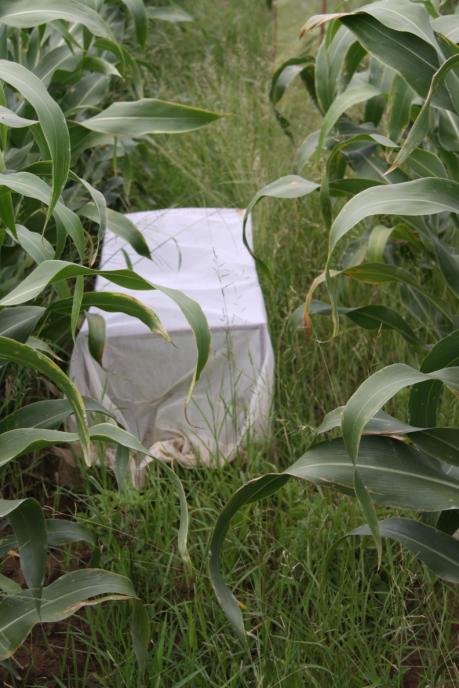
the third consecutive season. The cages were monitored weekly and the number
of emerging beetles recorded.
Fig. 1 Cage to determine emergence patterns over time of A. atromaculatus inside a
2. Height of exclusion plots
Exclusion cages (3 x 3 m2) were constructed with PVC pipes in a sorghum field with
a high natural infestation of A. atromaculatus at Potchefstroom (Fig. 2). There were
three treatments, viz. cages with commercially available mosquito netting put up
from soil level to a height of 1.2 m and 2.4 m respectively and an open cage with no
netting that served as the control treatment. Cages contained approximately 60
panicles of which most were flowering at the onset of the trial. Treatments were
replicated nine times. All beetles on panicles inside each cage were removed at the
onset of the trial. The numbers of beetles per cage were subsequently determined
at 1-day intervals for a period of nine days. Beetles occurring inside cages were
removed and released at least 3 m away from the cages after data were collected.

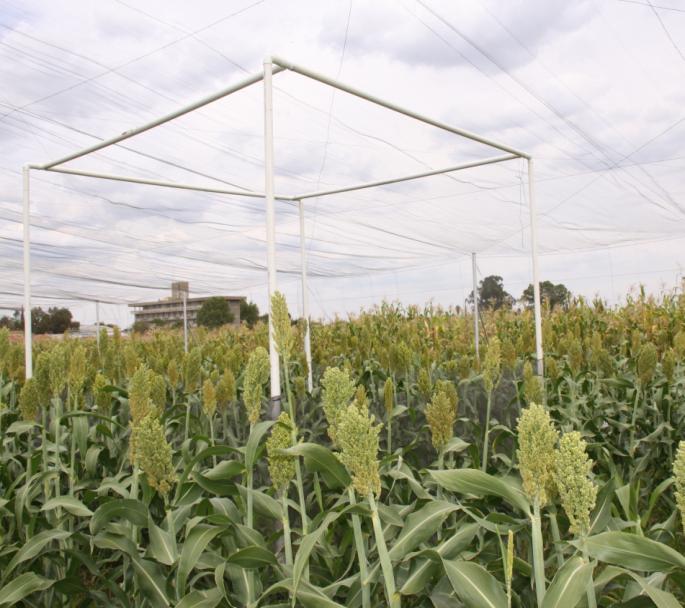

a: Open cage
b: Shade net put up from soil
level to a height of 1.2 m;
c: Shade net put up from soil
level to a height of 2.4 m
Fig. 2 Cages used to determine the height of exclusion plots.
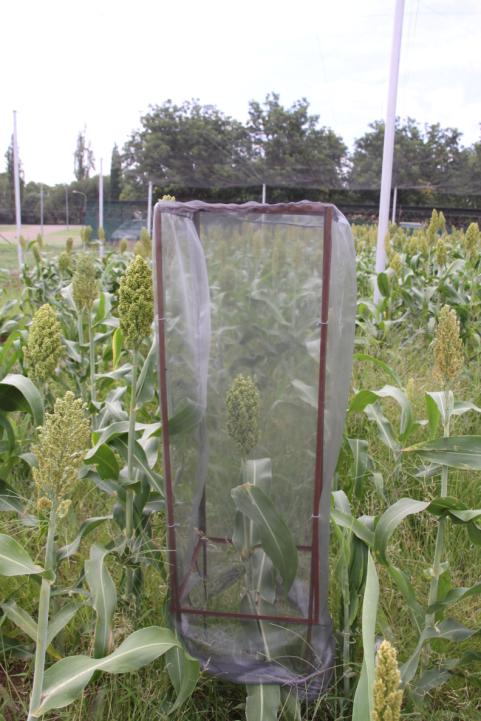
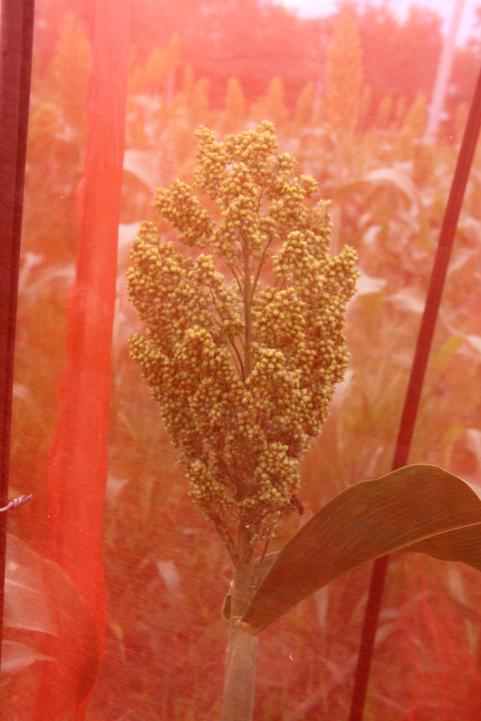
3. To develop techniques to confine A. atromaculatus beetles on sorghum
panicles without disturbing them/changing their behaviour
a) Size and colour of cages to determine the optimum type of cage
Sorghum was planted in pots and confined in cages (2.0 (l) x 1.0 (w) x 2.5m (h)) at
the onset of flowering during January 2011. Yellow, red, grey, and white cages were
evaluated. Adult Astylus beetles were collected from sorghum and maize fields and
used in this experiment. Sorghum panicles were infested at a level of 30 beetles per
panicle. There were 10 replications per treatment. Behaviour of the beetles was
recorded at 1-day intervals for a period of four days after infestation.
The trial was repeated under field conditions during March 2011. Yellow, red, grey
and white cages (0.5 (l) x 0.5 (w) x 1.6 m (h)) (Fig. 3) were evaluated. Individual
sorghum panicles were confined with cages and infested at a level of 20 beetles per
panicle. Almost all panicles in the field were in the milk to soft dough stages and the
beetles were nearing the end of their life cycle. The numbers of beetles which
abandoned the panicles to sit against cages were subsequently determined at 1-day
intervals for a period of four days after infestation.
Fig. 3 Different coloured panicle cages used in a field experiment.
4. Assessment of damage caused by A. atromaculatus beetles to sorghum
panicles
Thirty 3 x 3 m2 net exclusion cages of 1.2 m high were constructed in a sorghum
field at Parys, Free State province (26º58'S; 27º22'E). Cages contained
approximately 60 flowering panicles. All beetles on panicles inside each cage were
removed at the onset of the trial. Ten areas of similar size with flowering panicles
were demarcated in the same field. Astylus beetles occurring in these areas were
counted at four day intervals with minimum disturbance. Ten cages were removed
from panicles when in the soft dough stage as well as a further 10 cages when
panicles were in the hard dough stage. The remaining 10 cages served as the
uninfested control treatment. Natural infestation by Astylus beetles was allowed in
the areas where the cages were removed.
5. Monitor A. atromaculatus flights with a volatile compound
Weekly field trapping of A. atromaculatus adults was conducted at Potchefstroom
and Parys from January to March 2012. Traps consisted of yellow plastic buckets
(17 cm wide and 12 cm deep). Each bucket was filled to about two-thirds full with a
1% solution of Tween 80 baited and each trap was baited with or without 2-
phenylethanol (volatile compound) (Fig. 4). This chemical is an antennally active
sorghum panicle volatile which was released from the plastic bait-sachets at a rate of
approximately 4.2 mg/day. Trap catches were compared to unbaited control traps.
Twelve traps were placed per field with a 20 m inter-trap spacing and the first trap
was situated 20 m from the side of the field. The traps were set up at 1.2 m above
soil level. Trapped insects were removed after 24 hours and counted.
Repeated measures ANOVA was used to analyse the number of beetles sampled in
baited and unbaited traps over time using STATISTICA version 10 (Stasoft, Inc.,
Tulsa, Oklahoma, USA). Bonferroni correction was used to adjust for multi means
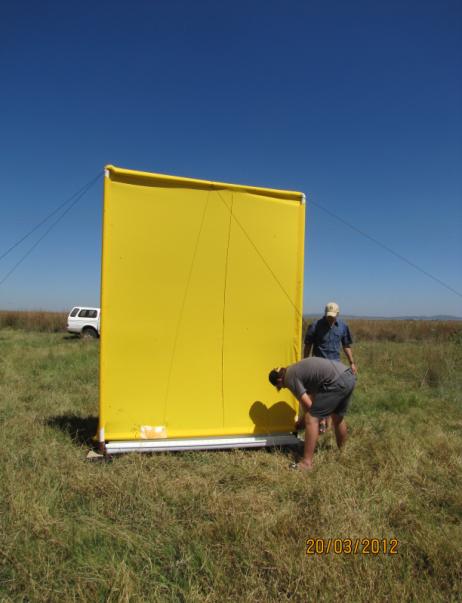
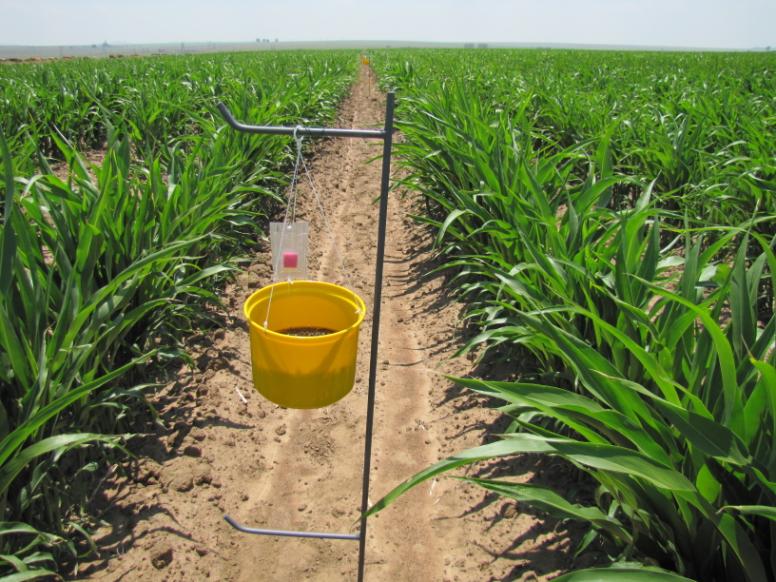
Fig. 4 Trap used to monitor A. atromaculatus flights.
6. Mass sampling of A. atromaculatus
A 3 x 3 m2 yellow screen was erected next to a sorghum field at Parys, on 20/3/2012
to determine if the colour and olfactory cues evaluated could be applied for mass
trapping of this pest. A gutter, filled two thirds with water, was placed below the
screen. One 10x15 cm2 sponge containing 2-phenylethanol (volatile attractant) and
sealed in a plastic bag was attached to each side of the screen above the gutter (Fig
5 a & b). Beetles were collected from the gutter after 24 hours and counted.
Fig 5. Yellow screen with a volatile compound for mass sampling of A.
7. Recording of A. atromaculatus beetles outside a sorghum field
A 0.5 x0.5 m2 square was placed randomly over grasses next to a sorghum field at
Parys on 20/3/2012 and the number of beetles in this area was counted. There were
four replications.
1. Astylus atromaculatus beetle emergence pattern
Very low numbers of beetles were recorded in cages during year 1. The numbers of
beetles sampled per 10 cages/maize field was one beetle during December and one
in January and only one beetle in the sorghum field during January, respectively.
Continuous rainfall resulting in water logging of fields during December 2010 until
March 2011 in Potchefstroom was regarded as a possible reason for these very low
numbers (Table 1). The trial was therefore repeated during year two to determine
whether water logging could have influenced the number of emerging beetles.
During the 2011/12 season no beetles were, however, recorded in any of these
cages, although the rainfall was generally lower than in the previous season (Table
1). Spotted maize beetle larvae of different instars, pre-pupae and pupae can occur
simultaneously in crop fields (Drinkwater, 1998). The fields were also inspected for
loss in plant stand which could have indicated the presence of larvae prior to and
after planting. There was, however, no indication of stand loss in any of the fields
Table 1. Monthly rainfall for the trial period during two seasons.
Total monthly rainfall (mm)
Fig. 6 Good plant stand in the fields where emergence cages were placed.
2. Height of exclusion plots
A successful and cheap cage technique was developed to keep beetles out of
sorghum plots. Constructing a net cage of 1.2 m high (panicle height) was effective
in keeping nearly all beetles out of plots. The mean numbers of beetles per cage
over the 9-day period are provided in figure 7. There were significant differences
between treatments and both treatments with netting had significantly fewer beetles
than the control treatment (P = 0.001). Virtually no beetles occurred inside the cages
surrounded by nets, even though the cages were open at the top.
Af
o
Height of cage (m)
Fig. 7 Mean number of A. atromaculatus beetles per cage in the field.
3. To develop techniques to confine A. atromaculatus beetles on sorghum
panicles without disturbing them/changing their behaviour
Size and colour of cages to determine the optimum type of cage
In the greenhouse beetles did not settle on the flowering panicles after infestation.
They abandoned the panicles to sit against the bags covering these panicles,
regardless of the colour of the cage. However, under field conditions, more than 85%
of beetles remained on sorghum panicles, with no significant difference between the
different coloured cages (P = 0.3). A previous study on A. atromaculatus beetles
under field conditions in maize showed that 89 % of a day is spent on activities other
than feeding (Fig. 8) (Esterhuizen, 1997).
Fig. 8 Percentage time spent daily on different activities by A. atromaculatus beetles
caged on maize plants in a field (Esterhuizen, 1997).
4. Assessment of damage caused by A. atromaculatus se beetles to sorghum
panicles
The number of beetles per demarcated area was low and varied between 80 and
240 beetles / 60 panicles during flowering and between 40 and 100 beetles / 60
panicles also during the soft dough stage. Few to no beetles were found in the
demarcated areas during the hard dough stage. There was no visible damage in the
demarcated areas.
The numbers of beetles in both Potchefstroom trials were too low to allow for a trial
to determine the economic injury – and threshold values.
5. Monitor A. atromaculatus flights with a volatile compound
Significantly more beetles were sampled at Parys than at the two Potchefstroom
sites (P < 0.05). The number of beetles sampled in Potchefstroom did not differ
significantly between the two sites (P > 0.05). There was no significant difference
between the number of beetles sampled in the baited and unbaited traps at
Potchefstroom ARC (F1,10 = 0.65, P = 0.44), but it did differ significantly at the other
two sites with significantly more beetles sampled in the baited traps (Potchefstroom:
F1,10 = 6.37; P < 0.05 and Parys: F1,10 = 31.37; P < 0.001). The field at the ARC was
a seed multiplication planted by the sorghum breeder and insecticides were applied
frequently resulting in very low numbers of beetles. Insecticides were also applied
once by the farmers at the Potchefstroom and Parys sites in mid February. These
applications were just prior to flowering and with no flower colour or pollen to attract
the beetles, resulted in very low numbers sampled even in the baited traps.
However, the number of beetles increased with the onset of flowering on 22/02/2012
at Potchefstroom and 29/02/2012 at Parys (Fig. 9). A sudden decrease in beetle
numbers followed after flowering was observed during the soft and hard dough
stages (Fig. 9).
F(1,10) = 31.37
P < 0.001
F(1,10) = 6.37
P < 0.05
of o. nn
Mea
Potchefstroom ARC
F(1,10) =0.65
* = Insecticide application
Fig. 9 Mean number of beetles caught in baited and unbaited traps at Potchefstroom
and Parys during the 2011/12 sorghum production season.
6. Mass trapping of A. atromaculatus
A total of 26 914 beetles were trapped in 24 hours.
7. Recording of A. atromaculatus beetles next to a sorghum field
Beetles occurred on grasses next to a sorghum field (Fig. 10) and an average of
127± 101beetles was sampled per 0.5 x 0.5 m2.
Fig. 10 Astylus atromaculatus beetles on grasses next to a sorghum field.
Discussion
According to Drinkwater (1998), the first A. atromaculatus beetles emerge from their
pupal cells under the soil surface from approximately mid December. Their numbers
increase rapidly and they are most abundant during January and February. In this
study the expected increase in number of beetles in emergence-monitoring cages
did not realise. It can therefore be concluded that infestation occurs from outside
instead of from inside fields. This result has important application value when putting
together an IPM strategy for A. atromaculatus. Because no clear emergence pattern
of A. atromaculatus adults could be observed from crop fields, a soil cultivation
practice to suppress this pest should not be included in an IPM strategy.
Contradicting results were obtained in the greenhouse and field trials with regard to
the cages confining beetles to panicles. These results cannot be explained. An
attempt to explain these results necessitated further investigation into the behaviour
of this insect. Being a polyphagous insect (e.g. insects feeding on a relatively large
number of plants from different families), acceptance or rejection of plants by A.
atromaculatus should depend on the availability of food and on their behavioural
responses to plant features. These features may be physical or chemical (Kevan &
Baker, 1984). Morphological characters of plants can influence acceptability, either
directly by providing suitable visual cues, or by influencing the ability of insects to
walk or bite into tissue. Furthermore, most species of phytophagous insects are
confined to certain plant parts, and this will determine the physical and chemical
attributes to which the insects respond (Bernays & Chapman, 1994).
The Melyridae, the family to which A. atromaculatus belongs, is known to be flower-
feeders. Florivory, or flower-feeding, is the consumption of flower tissue including
petals, sepals, pollen, or nectar resources (Kevan & Baker, 1984). Opportunistic,
facultative florivores may exploit floral cues as landing signals that facilitate foraging
efficiency (Courtney, 1982). From a plant's perspective, characteristics of the floral
display may represent evolutionary trade-offs because highly apparent flowers
attract florivores as well as pollinators (Gronquist et al., 2001). Two previous studies
found A. atromaculatus beetles to prefer yellow visual cues to red and green
(Esterhuizen, 1997; Van den Berg et al., 2008). It therefore suggests that this insect,
which is a flower forager and pollen feeder has, an innate attraction to yellow (Van
den Berg et al., 2008), which is also the colour visible when sorghum panicles
flowers. Investigation into the position at which the majority of beetles occur on
panicles, confirmed the flowering part of a panicle to be the preferred area (Fig. 11).
Completed flowering
(Beetles moving around)
Flowering Beetles mating and aggregating
Fig. 11 Astylus atromaculatus beetles are more abundant where the sorghum
panicle is flowering.
Height of flowers per se is also a factor in beetles' floral affinity (Kevan & Baker,
1984). These physical factors could all play a role in attracting A. atromaculatus
beetles to flowering sorghum panicles. These will all be important cues when
considering a push-pull strategy for control of this pest.
It is, however, not only visual cues, but also olfactory (smell) cues that play a role in
host attraction by A. atromaculatus beetles. A yellow trap combined with 2-
phenylethanol was suggested as a possible lure for monitoring populations of these
pollen beetles (Van den Berg et al., 2008). The different behaviour of the beetles
confined to flowering as opposed to post-flowering panicles found in this study, could
therefore partially be explained by the reproductive stage of the sorghum plants. In
the greenhouse trial, flowering plants were used, while the field trial was conducted
on plants in the milk- and soft dough stages (with a few flowering plants). It does,
therefore seem as if chemical communication strongly influences the behaviour of
this pest causing them to move around a lot and not settling on the plants they were
confined to. Since the greenhouse trial was conducted in January, it could be
assumed that young beetles were used as opposed to older beetles nearing the end
of their life cycle used in the field experiment during March.
It is unknown whether it is young or old beetles that cause damage to sorghum.
Active adult insects such as Astylus beetles, often have different dietary
requirements than larval stages, favouring foods with high caloric content for
powering flight muscles (Waldbauer & Friedman, 1991). It is assumed that animals
have evolved under natural selection to forage efficiently, that is, they should engage
in behaviour that maximizes the rate of net energy intake (Heinrich & Raven, 1972).
For example, female Japanese beetles, Popillia japonica must have enough energy
reserves to fly to oviposition sites, lay eggs, exit the soil, and fly back to host plants
before feeding again (Held & Potter, 2004). It can, therefore also be speculated that
young beetles could have different dietary requirements than older beetles, since
they need high energy levels for moving around, produce eggs and complete their
life cycle. Feeding activity of older beetles might differ from that of younger beetles
due to different energy requirements. This could have a profound effect in attempting
to determine an economic injury level and threshold level for control of A.
atromaculatus on sorghum. Although many beetles were sampled in traps at Parys,
few were found on sorghum panicles in the field during that time. This together with
the beetles sampled in traps while sorghum plants were in the vegetative stage and
no beetles occurred on the plants itself confirmed the strong visual and olfactory
cues reacted upon by A. atromaculatus beetles. Many beetles were found on grass
surrounding the sorghum field when beetle numbers were low inside the field.
Chemical communication among insects in general presents a diversity of forms and
functions. Pheromones that cause conspecifics to increase their density in the
vicinity of the pheromone source are known as aggregation pheromones (Ali &
Morgan, 1990). Astylus atromaculatus beetles were often observed forming groups
where mating took place. This behaviour has also been noted by Bedford et al.
(1974) and Esterhuizen (1997). The latter explained this behavior as aggregation for
the purpose of maximizing the opportunities of acquiring a suitable mate. Florivory
may also increase encounters with mating partners (Held & Potter, 2004). The
pheromones of A. atromaculatus have, however, not been identified. From the
behaviour observed, it seems as if a sex as well as an aggregation pheromone could
be present. Esterhuizen (1997) showed that beetles confined to a plant in the field
spend 37% and 22% of their day aggregating and mating, respectively. If not
confined, beetles move around actively in flowering sorghum fields. Esterhuizen
(1997) attributed the high frequency of beetles (28%) found against the gauze of a
cage confining sorghum panicles in a field by to their high frequency of mobility. In
nature, this is evident as beetles move randomly between individual plants and
between different plant species (Esterhuizen, 1997). It therefore seems as if A.
atromaculatus responds to an aggregation and sex pheromone as well as host-
related volatiles.
Conclusions
Astylus atromaculatus beetles infest sorghum fields from outside and does not
emerge and remain inside a field. Soil cultivation as a control strategy can therefore
be excluded. This pest reacts strongly to visual and olfactory cues, which include
yellow colour, plant volatiles and pheromones. As a result beetles moves around
frequently. This behaviour makes confinement with or without a chemical barrier
impossible. Calculation of an accurate economic injury and –threshold level using a
caging technique was therefore not possible. It will be possible to develop an
environmentally friendly IPM strategy for control of A. atromaculatus which will
include mass trapping and/or a push-pull strategy, if the beetles' reaction to visual
and olfactory cues can be explored more. The emphasis of a push-pull strategy
should be on a crop or flower that will pull the beetles away from the field during the
reproductive stages. Mass trapping at the time of peak emergence of the beetles in
an area, may suppress the beetle numbers effectively for the duration of the
cropping season since the insect has only one generation per year.
Three students used this work for their honours projects. One congress contribution
was presented and field data for one more year is needed to publish this research
References
ALI, M.F. & MORGAN, E.D. 1990. Chemical communication in insect communities: A
guide to insect pheromones with special emphasis on social insects. Biological
Reviews of the Cambridge Philosophical Society 65: 227-247.
BEDFORD, E.C.G., DE WET, P & ODENDAAL, J.S. 1974 Spotted maize beetle,
Astylus atromaculatus Blanch. Dasytidae, pp 7-10. In: Matthee, J.J. (ed.) Pests of
graminaceous crops in South Africa. Department of Agriculture and technical
Services, South Africa.
BERNAYS, E.A. & CHAPMAN, R.F. 1994. Host-plant selection by phytophagous
insects. Chapman & Hall, New York.
CASTOR, L.L. & FREDERIKSON, R.A., 1980. Fusarium and Curvularia grain mold
in Texas. pp. 93 - 192. In: Sorghum diseases, a world review: Proceedings of the
international workshop on sorghum diseases. Dec. 11-15, 1978. ICRISAT,
Patancheru, A.P. 502 324, India.
COURTNEY, S.P. 1982. Coevolution of pierid butterflies and their cruciferous food
plants. IV. Crucifer apparency and Anthocaris cardamines (L.) oviposition. Oecologia
DRINKWATER, T.W. 1997. The spotted maize beetle. Crop Protection Series No 6.
ARC - Grain Crops Institute.
DRINKWATER, T.W. 1998. The spotted maize beetle. ARC-Grain Crops Institute,
Crops Protection Series no. 6, Arc, Potchefstroom, South Africa.
ESTERHUIZEN, J.H. 1997. Bio-ecological aspects of the adult spotted maize
beetle,, Astylus atromaculatus Blanchard (Coleoptera: Melyridae). Unpublished MSc
thesis, University of the Orange Free State, Bloemfontein, South Africa.
GRONQUIST M., BEZZERIDA, A., ATTYGALE, A., MEINWALD, J., EISNER, M. &
EISNER, T. 2001. Attractive and defensive functions of the ultraviolet pigments of a
flower (Hypericum calycinum). Proc. Natl Acad. Sci USA 98: 13745-13750.
HARRIS, K.M., 1995. World review of recent research on panicle insect pests of
sorghum and pearl millet. pp. 7 – 25. In: Panicle insect pests of sorghum and pearl
millet: Proceedings of an International Consultative Workshop, 4-7 Oct 1993,
ICRISAT. Patancheru, A.P. 502 324, India.
HEINRICH, B. & RAVEN, P. 1972. Energetics and pollination ecology. Science 176:
HEPPERLEY, P.R., FELCIANO, C. & SOTOMAYOR, A., 1982. Chemical control of
seed borne fungi of sorghum and their association with seed quality and germination
in Puerto Rico. Plant Dis. 66, 902-904.
HELD, D.W. & POTTER, D.A. 2004. Floral affinity and benefits of dietary mixing with
flowers for a polyphagous scarab, Popillia japonica Newman. Oecologia 140: 312-
IBRAHIM, O.E., NYQUIST, W.E. & AXWELL, J.D., 1985. Quantitative inheritance
and correlations of agronomic and grain quality traits of sorghum. Crop Sci. 25,
KEVAN, P.G. & BAKER, H.G. 1984. Insects on flowers. In: Huffaker, C.B., Rabb R.L.
(eds) Ecological entomology. Wiley, New York, pp 607-631.
MAITI, R.K., RAJU, P.S. & BIDINGER, F.R., 1985. Studies on germinability and
some aspects of pre-harvest physiology of sorghum grain. Seed Sci. Tech. 13: 27 –
VAN DEN BERG, J., TORTO, B., PICKETT, J.A., SMART, L.E., WADHAMS, L.J. &
WOODCOCK, C.M. 2008. Influence of visual and olfactory cues on field trapping of
the pollen beetle, Astylus atromaculatus (Col.: Melyridae). J. Appl. Entomol. 132:
WALDBAUER, G.P. & FRIEDMAN, S. 1991. Self-selection of optimal diets by
insects. Annu. Rev. Entomol. 36: 43-63.
We are grateful for the funding provided by the Sorghum Trust for this project.
Source: http://www.maizetrust.co.za/upload/WEBSITE/ResearchMarket&Production/2012/20160211NWU%20Final%20report%20Maize%20Beetle%202012.pdf
Untitled
OMCR 2014 ;6 (3 pages) Pregnancy delusion hinders the diagnosis of achalasia in a patientwith life-threatening emaciation Rafael Dias Lopes, Claudio E. M. Banzato and Amilton Santos Jr* Department of Psychiatry, Faculty of Medical Sciences, University of Campinas (Unicamp), Campinas, SP, Brazil *Correspondence address. Department of Psychiatry, Faculty of Medical Sciences, University of Campinas (Unicamp),Campinas, SP 13083-970, Brazil. Tel: þ55-19-3521-7206; Fax: þ55-19-3521-7206;E-mail: [email protected]
Untitled
Bonitas Medical Fund ¥ R2.2 billion reserves¥ 35.7% solvency ratio¥ A+ Global Credit Rating¥ Administration cost only 9.2% of gross contribution income Number of principal members DISTRIBUTION OF MEMBERS (August 2010) ¥ Free cover for the fourth and subsequent child dependants ¥ Child rates for students up to the age of 24